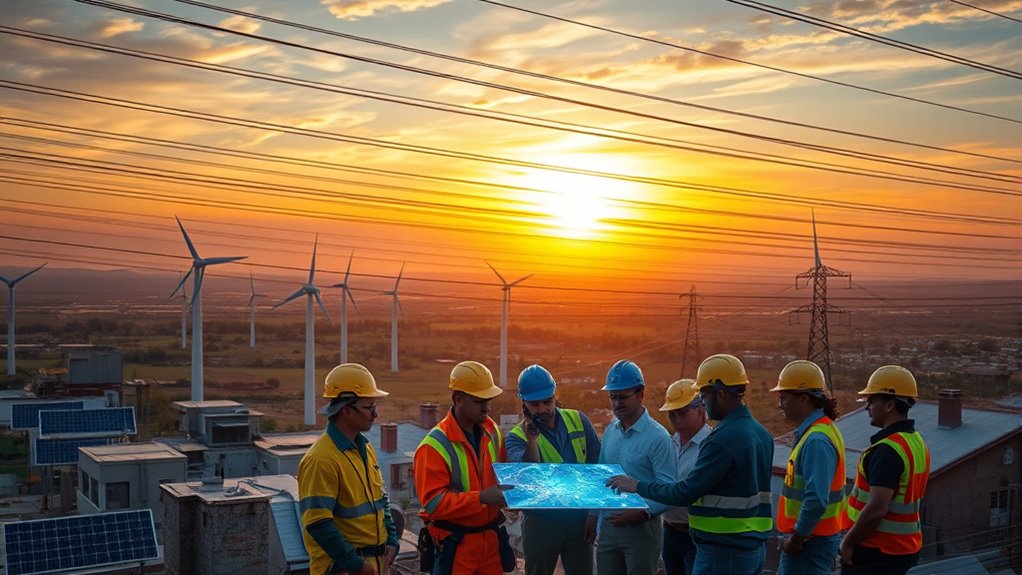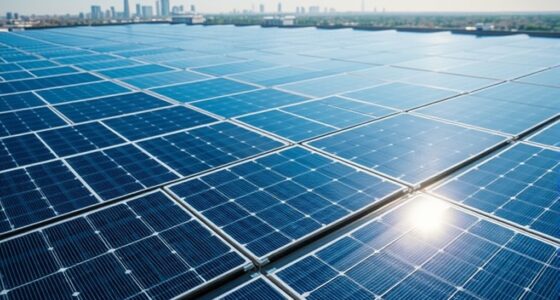Smart grids are the backbone of a sustainable energy future. They empower you to manage energy use more efficiently, integrate renewable sources, and optimize distribution with real-time data. By utilizing advanced technologies like IoT and data analytics, smart grids enhance energy efficiency and reliability. Plus, they engage consumers in energy-saving practices. You’ll discover even more about how smart grids shape our energy landscape and their benefits as you explore further.
Key Takeaways
- Smart grids integrate renewable energy sources, enhancing sustainability and reducing reliance on fossil fuels for energy production.
- Advanced metering infrastructure provides real-time data, enabling efficient energy consumption and empowering consumers to make informed decisions.
- Data analytics optimize grid performance, identifying inefficiencies and facilitating dynamic adjustments in energy distribution for better resource management.
- Vehicle-to-Grid technology allows electric vehicles to act as energy storage, contributing to grid stability and promoting renewable energy use.
- Consumer engagement in demand-response programs supports a more sustainable grid by balancing supply and demand through active participation.
Understanding Smart Grids: A New Era in Energy Management
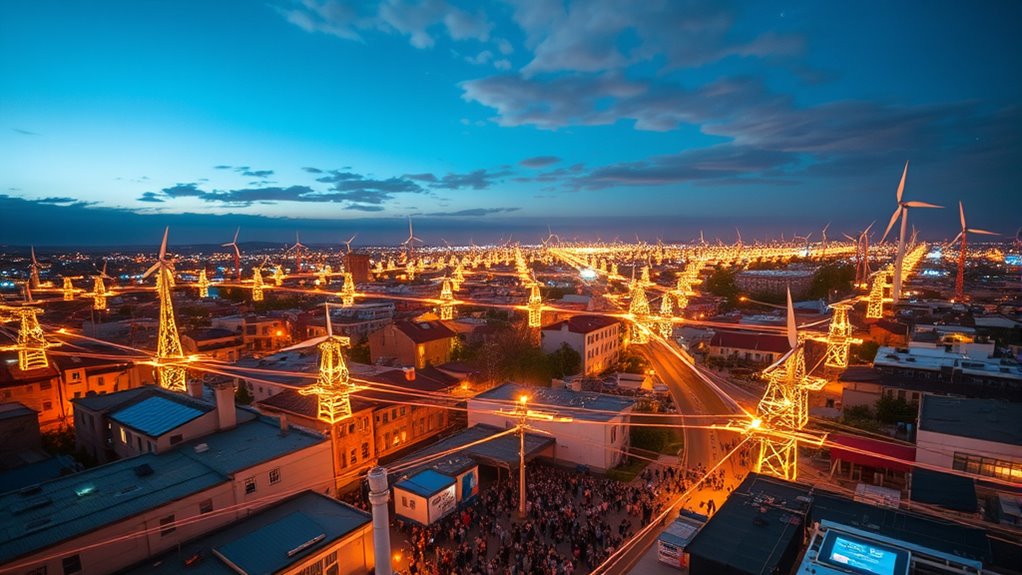
Smart grids are advanced networks that integrate digital technologies to optimize energy production, distribution, and consumption. They facilitate the seamless integration of renewable energy sources like solar and wind, allowing you to benefit from variable energy outputs. Smart grids also improve overall energy efficiency by adjusting production based on real-time demand. Additionally, innovative settings in smart grids can maximize the efficiency of energy distribution systems. Heat pumps, for instance, can significantly reduce energy consumption by up to 50%, contributing to a more sustainable energy future. Furthermore, the integration of heat pump technology within smart grids enhances their effectiveness by promoting the use of renewable energy sources and reducing reliance on fossil fuels.
With real-time monitoring and control, smart grids respond dynamically to changes in demand and supply. You’ll also gain access to real-time information on energy costs and usage, empowering you to make informed decisions.
Key Components of Smart Grid Technology

Understanding the key components of smart grid technology is crucial for harnessing its full potential in energy management.
Smart meters give you real-time data on energy consumption, helping optimize usage. Sensors and monitoring systems use IoT to track grid conditions and quickly identify issues. Communication networks facilitate real-time data exchange, enhancing decision-making across the grid. Smart grids enhance efficiency and reliability of electricity distribution, ensuring a stable energy supply. The integration of energy-efficient models into smart grid systems can significantly reduce overall energy consumption. Furthermore, the rise in venture capital participation in renewable energy projects is fueling advancements in smart grid technologies. Incorporating plant-based sources of energy into smart grid systems can also support sustainability efforts.
Distributed energy resources (DERs), like solar and wind, integrate renewable sources for a reliable energy supply. Energy storage systems guarantee you have power during high-demand periods.
Advanced metering infrastructure (AMI) enables two-way communication, while data analytics aligns energy production with consumption. Together, these components create a responsive, efficient energy network that benefits both consumers and utilities.
Enhancing Energy Efficiency Through Smart Grids
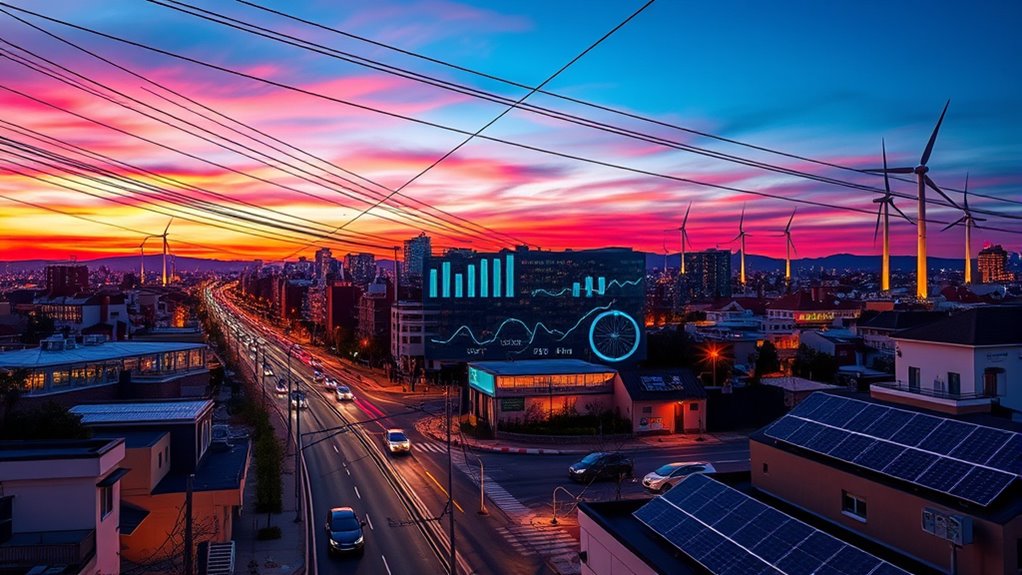
Smart grids markedly enhance energy efficiency by providing real-time insights and automation that streamline energy management.
With real-time monitoring, you can optimize energy plants and distribution systems, addressing inefficiencies as they arise. Advanced data analytics identify trends and potential issues, empowering you to make informed decisions. This continuous real-time monitoring ensures that plant operators can adjust performance based on changing market conditions. Furthermore, integrating energy-efficient systems can significantly reduce overall energy demand and operational costs. Additionally, the incorporation of commercial grade heat pumps within smart grids can further bolster energy efficiency in larger buildings and industrial applications. Modern heat pumps designed with quieter operation also contribute to a more pleasant working environment.
Automation plays an essential role as it predicts machine failures and triggers operational responses, preventing waste. By integrating renewable energy sources, smart grids reduce reliance on fossil fuels, aligning with sustainability goals.
In addition, real-time data allows for cost monitoring and optimization, ensuring energy usage is as economical as possible.
Ultimately, smart grids minimize energy waste and enhance distribution efficiency, making energy consumption smarter and more sustainable for everyone.
The Role of IoT in Smart Grid Infrastructure
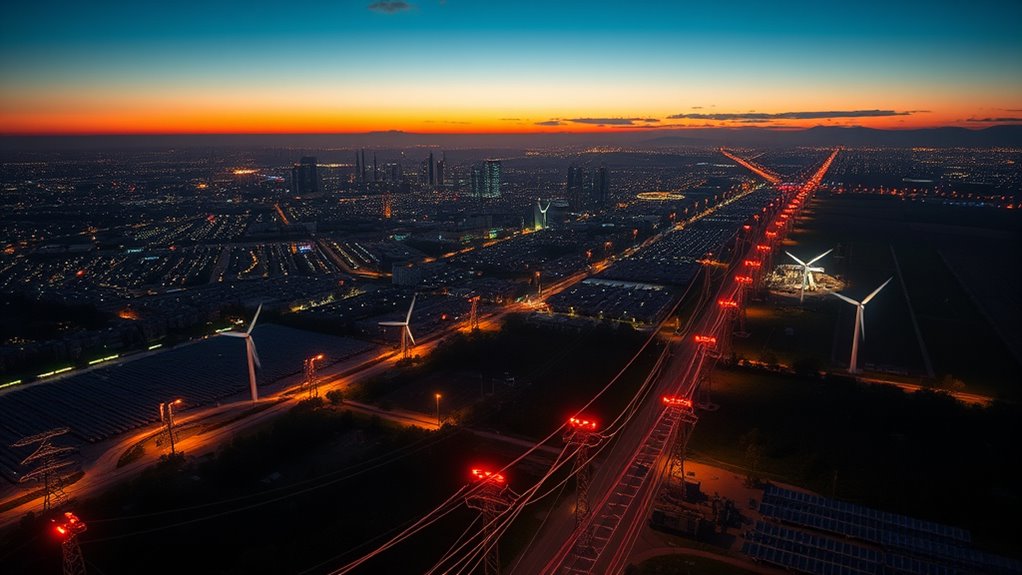
While traditional energy grids struggle with inefficiencies, the integration of the Internet of Things (IoT) into smart grid infrastructure revolutionizes energy management.
IoT enhances real-time monitoring through advanced metering infrastructure, allowing you to track your energy consumption accurately. With two-way communication, utilities can dynamically adjust energy supply based on demand, optimizing distribution and reducing strain during peak hours. This integration of advanced technologies enables consumers to become energy producers through renewable sources, such as solar energy, which can be harnessed even at night through storage solutions. Regular maintenance of energy systems can enhance their efficiency, similar to how regular maintenance can extend the life of a pop-up camper’s canvas. Additionally, implementing risk management strategies can help ensure the reliability of these energy systems.
Predictive maintenance identifies equipment issues early, lowering downtime and costs. Additionally, IoT facilitates remote utility management and smart appliance integration, giving you more control over your energy use.
Integrating Renewable Energy Into the Smart Grid
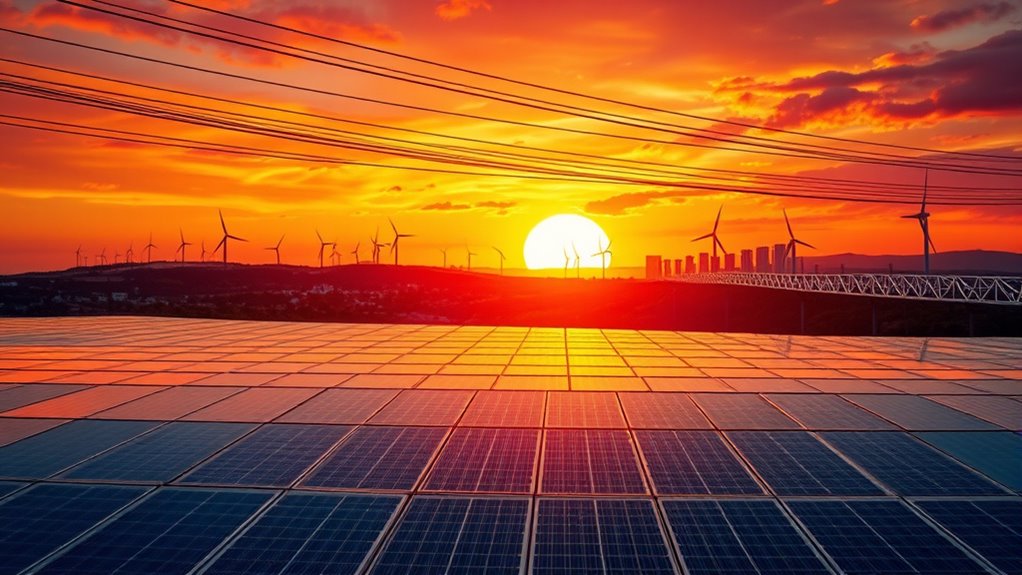
As renewable energy sources like solar and wind become more prevalent, integrating them into the smart grid is vital for creating a sustainable energy future.
Advanced Metering Infrastructure (AMI) enables you to monitor energy consumption in real-time, while AI and machine learning optimize the balance between production and consumption. Decentralization of energy sources allows for localized energy generation, enhancing grid resilience. Additionally, balance and coordination development is essential in promoting effective energy management and distribution. The integration of solar charge controllers ensures that energy systems operate efficiently and safely. Furthermore, the implementation of sustainable practices in energy generation can significantly reduce environmental impacts associated with traditional fuel sources.
Advanced Metering Infrastructure (AMI) allows real-time energy monitoring, while AI and machine learning enhance the balance of energy production and consumption.
Phasor Measurement Units (PMUs) enhance grid stability by analyzing electrical waves.
Vehicle-to-Grid (V2G) technologies allow electric vehicles to serve as energy storage, while High-Voltage Direct Current (HVDC) transmission supports long-distance energy transport.
You’ll also benefit from grid modernization efforts, enhancing resilience against natural disasters.
With predictive maintenance and advanced distribution management systems, the smart grid guarantees reliability and maximizes the benefits of renewable energy integration.
Overcoming Challenges in Smart Grid Implementation

Overcoming the challenges of smart grid implementation requires a multifaceted approach that addresses technological, cybersecurity, regulatory, financial, and consumer engagement issues. You’ll need to tackle interoperability problems by establishing standardized protocols and guaranteeing component compatibility. The complexity of integrating various technologies demands sophisticated management systems. Furthermore, smart grids’ functionality includes self-healing capabilities that minimize disruptions during outages, which is vital for reliability. Cybersecurity is another critical concern; you must implement robust measures to protect against attacks and safeguard data privacy. Essential oils for respiratory health can play a role in improving air quality, which is vital for the overall effectiveness of smart grid systems in urban areas. Additionally, regular monitoring of production quantity variance can help identify inefficiencies in energy use patterns across the grid. Outdated regulations can stifle progress, so advocating for updated frameworks is essential. Financially, high upfront costs and infrastructure upgrades present barriers, making government incentives indispensable. Additionally, understanding average household energy use helps to inform strategies for demand response and energy efficiency. Finally, engaging consumers and fostering acceptance is crucial for successful adoption. By addressing these challenges, you pave the way for a more sustainable energy future.
The Importance of Data Analytics in Energy Distribution
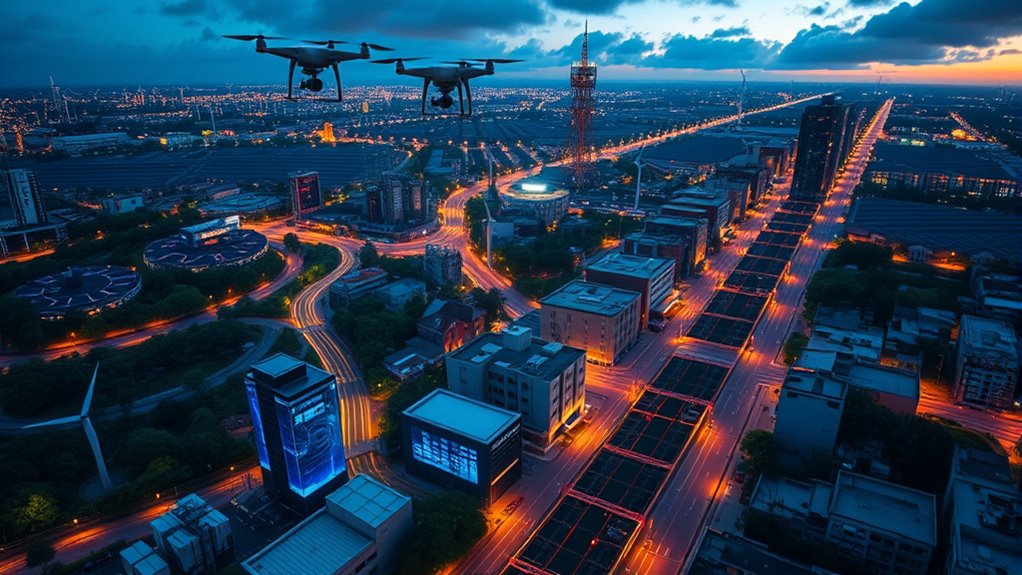
Implementing smart grids opens the door to leveraging data analytics, which plays a pivotal role in optimizing energy distribution. You can analyze vast data from smart meters and sensors to enhance grid performance, identify patterns, and predict potential failures.
Real-time monitoring enables you to make dynamic adjustments, boosting stability and reliability. By employing predictive maintenance, you can spot faults early, reducing costly outages. Data-driven insights also improve efficiency, ensuring a consistent energy supply while managing capacity constraints. Moreover, asset management optimizes the health and performance of grid components, further enhancing operational effectiveness. AI-enhanced threat detection is also crucial for safeguarding smart grid systems against cyber threats, ensuring their reliability and security.
Additionally, analytics helps forecast renewable energy generation, optimizing power dispatch and integrating these sources into the grid effectively. With the rise of 5G networks, data transmission speeds will enhance the responsiveness of smart grids. Ultimately, data analytics empowers you to manage energy better, promoting sustainability and reducing environmental impact.
Consumer Engagement and Smart Grid Adoption

While the shift to smart grids offers numerous benefits, engaging consumers is essential for successful adoption. About 62% of you review your energy usage monthly, and 82% of those who do make adjustments to improve efficiency. Additionally, with over 103 million smart meters installed nationwide, consumers have greater access to real-time data for managing their energy consumption.
By participating in demand-response programs, you can actively help balance supply and demand, reducing peak loads on the grid. However, challenges like high upfront costs and concerns about data privacy can deter participation. Educational campaigns are vital to enhance understanding of smart grid benefits. Your involvement not only helps you manage energy costs but also contributes to a more sustainable grid.
Ultimately, your engagement is key to realizing the full potential of smart grids and ensuring a reliable energy future.
Future Trends in Smart Grid Development

As technology evolves, smart grids are set to transform the energy landscape markedly. You’ll see the integration of AI and IoT enhancing efficiency by analyzing real-time data and predicting energy demand. Renewable energy sources like solar and wind will become more seamlessly integrated, reducing reliance on fossil fuels. IoT connects various parts of the smart grid network, facilitating communication between renewable plants and consumers, which will further enhance the overall system’s efficiency. Blockchain technology will simplify energy transactions through smart contracts, allowing for peer-to-peer trading. Decentralized energy systems will improve resilience, while advanced energy storage solutions will mitigate the intermittency of renewables. With 5G connectivity, low-latency communication will enhance grid management. Machine learning and the Internet of Energy (IoE) will optimize energy distribution, ultimately creating a more flexible and sustainable energy framework for the future.
The Economic Benefits of Smart Grids for a Sustainable Future

Smart grids not only pave the way for advanced technology integration but also bring significant economic benefits that contribute to a sustainable future.
By reducing operational costs through predictive maintenance and minimizing energy losses, you can enjoy lower electricity bills while utilities save on management expenses. Smart grids significantly enhance energy efficiency by minimizing transmission and distribution losses, ensuring that energy is utilized more effectively.
Smart grids optimize resource allocation and enhance energy distribution, ensuring reliable electricity and reducing waste. They seamlessly integrate renewable sources like solar and wind, cutting reliance on fossil fuels and lowering emissions.
This shift supports job creation in various sectors, boosts local economies, and promotes sustainable economic models.
Frequently Asked Questions
How Do Smart Grids Affect Energy Prices for Consumers?
Smart grids affect your energy prices by managing demand and integrating renewable sources.
With real-time pricing, you can shift your energy use to off-peak times, which lowers your bills. Advanced metering gives you insights into your consumption, helping you make informed decisions.
What Role Do Governments Play in Smart Grid Development?
As the saying goes, “Many hands make light work.”
Governments play an essential role in smart grid development by providing funding, establishing policies, and setting standards. They invest in infrastructure and create grant programs to encourage private investment.
Additionally, they spearhead initiatives for cybersecurity and renewable energy integration. By collaborating with local and international partners, governments guarantee smart grids evolve to meet future energy demands effectively and sustainably.
How Can Consumers Participate in Smart Grid Initiatives?
You can actively participate in smart grid initiatives by enrolling in demand response programs, which let you adjust your energy usage during peak times.
Using smart meters helps you track your consumption, making it easier to adopt energy-efficient habits. Investing in smart appliances and thermostats can optimize your energy use.
Additionally, consider generating your own energy with solar panels and engaging with community programs that promote awareness and participation in sustainable energy practices.
What Are the Environmental Impacts of Smart Grids?
Smart grids have significant environmental impacts by reducing emissions and enhancing energy efficiency.
By integrating renewable energy sources like solar and wind, you help decrease reliance on fossil fuels. This change not only cuts CO2 emissions but also improves air quality by lowering harmful pollutants.
Additionally, smart grids optimize energy distribution, ensuring you use energy more effectively, which contributes to a more sustainable energy system overall.
Your participation in this transformation can make a real difference.
How Can Smart Grids Improve Energy Access in Remote Areas?
Imagine a world where remote areas buzz with energy like a bustling city!
Smart grids can turn that dream into reality. You’ll experience reliable electricity that empowers local businesses and transforms lives.
With real-time monitoring and renewable energy integration, you’ll enjoy less downtime and more opportunities.
Plus, job creation and enhanced healthcare can elevate your community.
It’s not just power; it’s a revolution in energy access that’ll light up your future!
Conclusion
To sum up, smart grids are like the nervous system of our energy landscape, connecting and managing resources for a sustainable future. By embracing this technology, you’re not just improving energy efficiency but also paving the way for a cleaner environment. As renewable energy sources and advanced analytics become integral, you’ll see how smart grids can transform your energy experience. It’s time to engage with this innovation and be part of a brighter, more efficient tomorrow.
